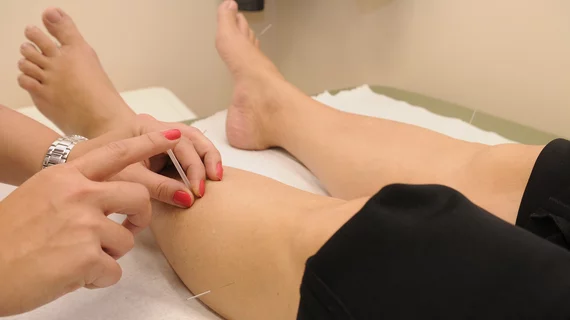Acupuncture can reduce treatment-related joint pain in breast cancer patients
Acupuncture treatments reduce joint pain in women with early-stage breast cancer, according to a new study published in JAMA, though its clinical importance remains unclear.
“Aromatase inhibitors have proven efficacy for the treatment of hormone-sensitive breast cancer,” wrote Dawn L. Hershman, MD, MS, of Columbia University Medical Center in New York, and colleagues. “However, many patients experience adverse effects, including aromatase inhibitor–related arthralgias (pain and stiffness), which occur in approximately 50 percent of patients and contribute to nonadherence with therapy.”
Previous studies have shown that acupuncture can help treat aromatase inhibitor–related arthralgias, the authors added, but small sample sizes and ineffective blinding led to uncertainty about the outcomes. Hershman et al. organized a randomized clinical trial at 11 different academic centers and clinical sites from March 2012 to February 2017. More than 200 postmenopausal women with early-stage breast cancer participated in the study. All patients were taking an aromatase inhibitor and experiencing pain. While more than 100 women received acupuncture treatments for 12 weeks, more than 50 received “sham acupuncture” treatments during the same timeframe. More than 50 women were also in a control group; they received no acupuncture.
The authors explained how their work differed from previous studies of the impact acupuncture can have on joint pain.
“The lack of a placebo effect in prior acupuncture trials raised concerns about the integrity of the sham blinding, unintentional crossover in the sham treatment groups, or a possibility of a physiological effect of the sham,” they wrote. “The current trial was designed with a waitlist control group to address prior concerns about the sham effects.”
Overall, the mean Brief Pain Inventory Worst Pain (BPI-WP) score for patients receiving acupuncture decreased by 2.05 points after six weeks. In the sham acupuncture group, the mean BPI-WP score decreased by 1.07 points. In the control group, it decreased by 0.99 points. The authors noted that this difference between the acupuncture and sham acupuncture groups was “statistically significant,” but “the observed improvement was of uncertain clinical importance.”
“The adjusted mean between-group difference at six weeks was 0.92 points for true acupuncture vs sham acupuncture and 0.96 points for true acupuncture vs waitlist control,” the authors wrote. “Although there is some uncertainty about the clinical meaning of this between-group difference, the observed difference in this study is consistent with other randomized studies of pain control interventions, which have reported between-group mean differences ranging from 0.7 to 1 points.”
The authors also noted that, after 12 weeks, when compared to the sham acupuncture group, patients in the acupuncture group reported “statistically significant improvements in average pain, but not significant improvement in worst pain, pain interference, pain severity or worst stiffness.” Forty-seven percent of patients in the acupuncture group did experience grade 1 bruising, compared to 25 percent of the sham acupuncture group.

